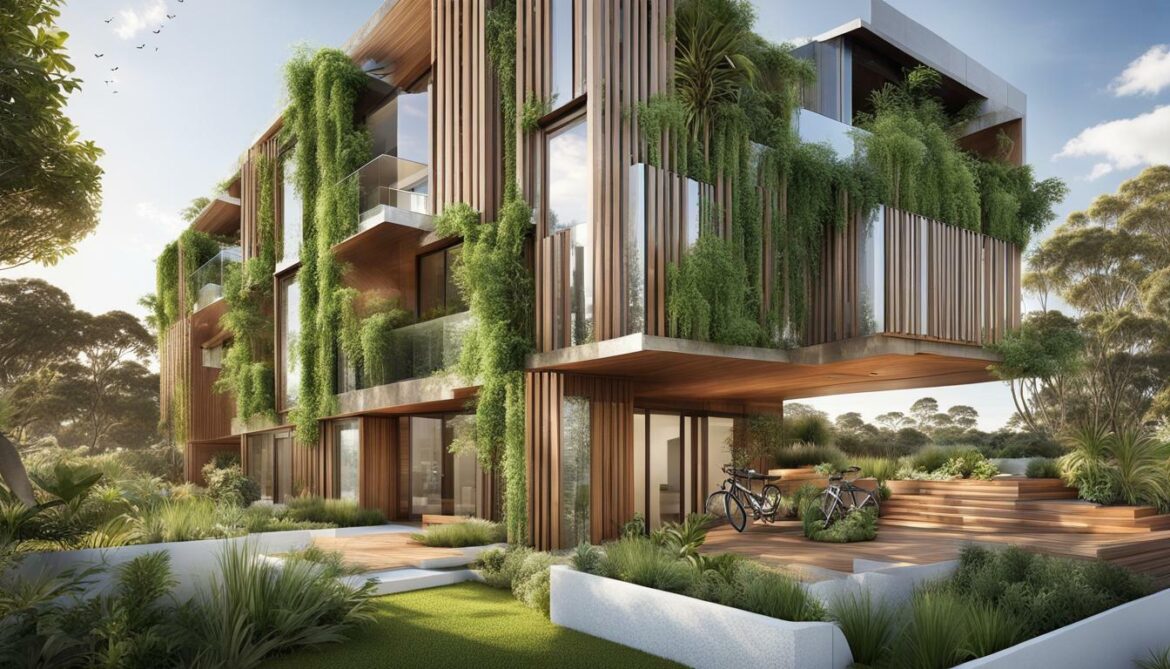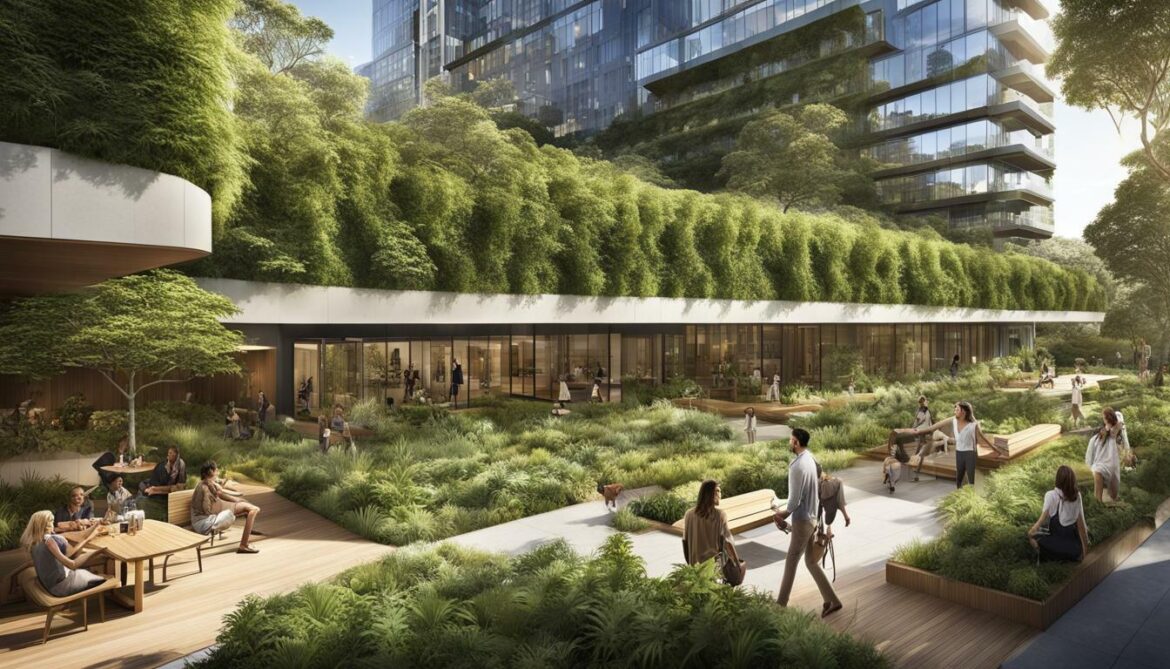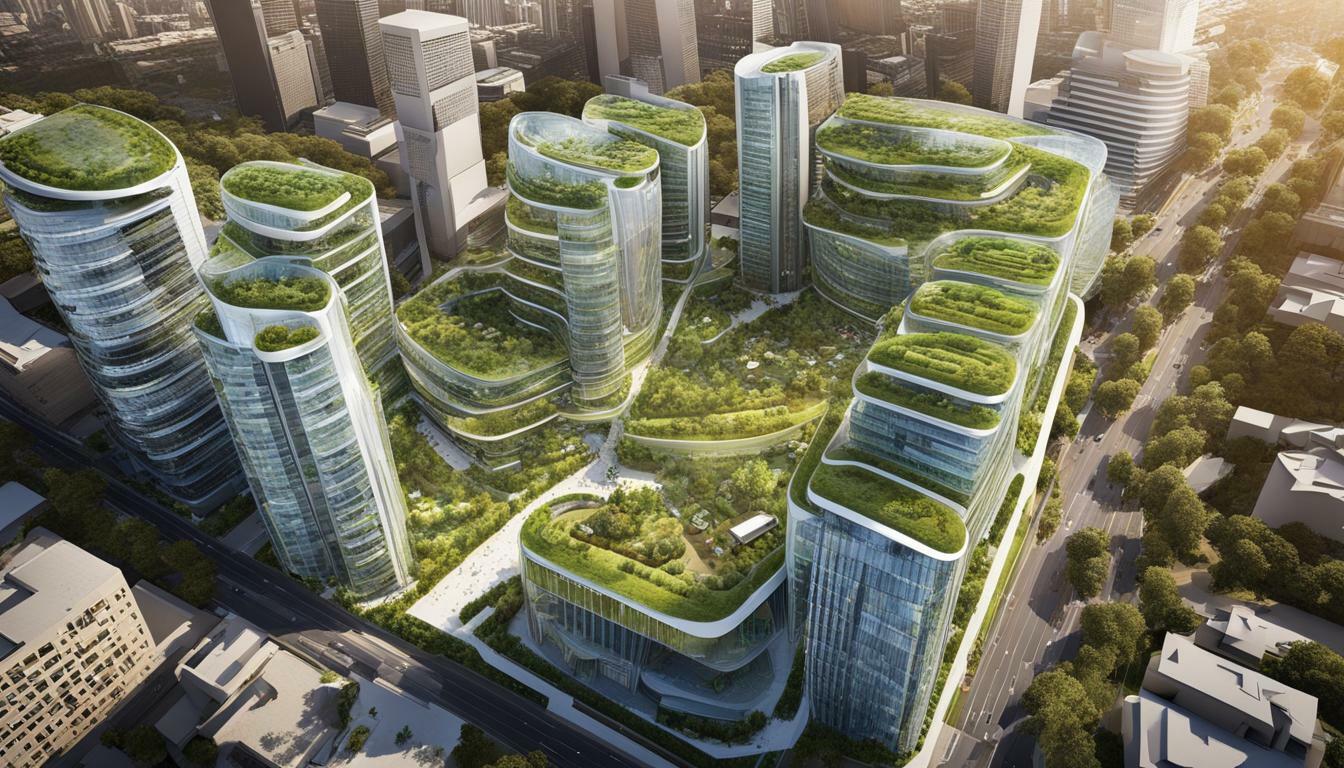As global environmental concerns continue to rise, the need for sustainable building practices becomes more pressing than ever. Australia has emerged as a leader in green building design, with numerous eco-friendly constructions that employ energy-efficient technologies, utilize sustainable building materials, and adopt eco-friendly construction practices. These sustainable marvels prove that eco-friendliness and functionality can go hand in hand.
From commercial buildings to residential communities, Australia’s top green buildings have become an inspiration for architects, developers, and policymakers worldwide. The country’s commitment to sustainable architecture reflects its vision for a greener and more sustainable future for all.
Australia Top Green Buildings Key Takeaways:
- Australia has emerged as a leader in sustainable architecture and green building design.
- Sustainable building practices such as the use of eco-friendly construction materials, energy-efficient technologies, and renewable energy sources are essential in creating a greener future.
- The green building certification process ensures that constructions are evaluated based on their sustainability criteria.
Sustainable Architecture in Australia
Australia is home to some of the world’s most innovative and sustainable architecture, with a focus on green building design and the use of sustainable building materials. Architects and builders are embracing eco-friendly construction practices to create energy-efficient buildings that reduce carbon emissions and promote a greener future.
One example of sustainable architecture in Australia is the Pixel Building, located in Melbourne. This building uses a range of sustainable features, including rainwater harvesting, solar energy, and natural ventilation, to reduce its environmental impact. The Pixel Building was also awarded a 6-star green building certification, the highest rating in Australia.
Another notable example is the International House Sydney, which boasts a unique façade made from sustainable timber. The use of timber not only reduces the building’s carbon footprint, but also creates a warm and inviting atmosphere for its occupants. The building also incorporates a range of energy-efficient features, such as solar panels and a rainwater harvesting system.
When it comes to green building design, architects in Australia are pushing the boundaries of what is possible. The Council House 2 in Melbourne is a prime example of this, featuring a façade made from 50,000 aluminium ‘petals’ that open and close throughout the day to regulate the building’s temperature and reduce energy consumption. The building also utilizes a range of sustainable materials, including recycled timber and low-VOC paint.

These are just a few examples of the sustainable architecture on display in Australia. With a focus on eco-friendly construction practices and sustainable building materials, Australia’s top green buildings are leading the way in creating a more sustainable future for us all.
Eco-Friendly Construction Practices
Constructing eco-friendly buildings involves more than using sustainable building materials. It requires adopting sustainable construction practices that promote resource conservation, minimize waste, and reduce the carbon footprint of the building. These practices are integral to the design and construction of Australia’s top green buildings.
One of the key sustainable building practices in Australia is rainwater harvesting. This involves collecting and storing rainwater, which can be used for a variety of non-potable purposes such as watering plants, flushing toilets, and cleaning. By reducing the demand for potable water, rainwater harvesting helps conserve this precious resource.
Natural ventilation is another sustainable building practice that is widely used in Australia. By designing buildings that maximize natural ventilation, it is possible to reduce the need for mechanical ventilation, which can consume large amounts of energy. Natural ventilation also improves indoor air quality and thermal comfort.
| Sustainable Building Materials |
Description |
| Bamboo |
A fast-growing, renewable material that can replace timber for flooring and structural elements. |
| Recycled steel |
Steel that has been salvaged and recycled for use in construction, reducing the need for raw materials. |
| Low VOC paint |
Paint that has low levels of volatile organic compounds (VOCs), reducing the amount of harmful chemicals released into the air during painting. |
Renewable energy sources are also an important part of sustainable building practices in Australia. Buildings can be designed to incorporate solar panels, wind turbines, and geothermal systems, among others, to generate clean energy on site. This reduces the reliance on fossil fuels and lowers greenhouse gas emissions.
By adopting these and other sustainable building practices, Australia’s top green buildings are leading the way in eco-friendly construction. These buildings not only reduce the environmental impact of construction but also promote healthier and more sustainable communities.

Achieving Green Building Certification
In Australia, green building certification is a rigorous process that evaluates a building’s sustainability across a range of criteria. There are several certification systems available, including the Green Star rating system, which is widely recognized as a leading benchmark for sustainable building design and performance.
To achieve Green Star certification, buildings must attain a certain number of points across nine categories, including energy, water, materials, and indoor environment quality. The certification process encourages sustainable building practices and provides a framework for measuring a building’s environmental impact.
The benefits of obtaining Green Star certification are numerous. Certified buildings are more energy-efficient, have lower operating costs, and contribute to a healthier indoor environment for occupants. They also have a higher market value and appeal to a growing number of eco-conscious tenants and buyers.
Moreover, Green Star certification supports Australia’s commitment to reducing greenhouse gas emissions and transitioning towards a more sustainable future. According to the Green Building Council of Australia, the country has the highest number of Green Star-certified buildings per capita in the world, demonstrating its leadership in sustainable building practices.

“Green building certification is a crucial step towards creating a more sustainable future. By encouraging sustainable building practices and measuring a building’s environmental impact, we can reduce our carbon footprint and create healthier, more resilient communities.”
Notable Examples of Green Buildings in Australia
Australia is home to some of the most innovative and sustainable architecture in the world. From towering skyscrapers to eco-friendly residential communities, green building design is at the forefront of sustainable development in Australia.
One notable example is the One Central Park building in Sydney. Designed by Jean Nouvel and PTW Architects, the building features a cantilevered heliostat that reflects natural light into the building’s public park and atrium. The building also boasts a vertical garden that covers over 50% of the building’s façade, reducing its energy consumption and carbon footprint.

Another example is The Commons, a sustainable apartment complex in Melbourne. The building features solar panels, a rooftop garden, and rainwater harvesting, all of which contribute to the building’s energy-efficiency and environmental sustainability. The apartments are also designed to promote natural ventilation and reduce reliance on electrical heating and cooling systems.
The council house 2 (CH2) building in Melbourne is another leading example of sustainable building design in Australia. The building is designed to be carbon-neutral, with energy-efficient features such as a double-skin façade, mixed-mode ventilation, and solar photovoltaic panels.
Finally, the Pixel building in Melbourne is Australia’s first carbon-neutral office building. The building features a range of energy-saving technologies, including a rainwater harvesting system and a façade that automatically adjusts to the sun’s position to maximize natural light and reduce energy consumption.
These and many other green buildings in Australia demonstrate the country’s commitment to sustainable design and environmental responsibility.
Sustainable Architecture in Australia
Australia has become a leader in sustainable architecture and green building design. The country’s commitment to eco-friendly construction practices and sustainable building materials has resulted in the creation of some of the most innovative and energy-efficient buildings in the world.
From the towering One Central Park in Sydney, which is covered with over 35,000 plants, to the carbon-neutral Council House 2 in Melbourne, which uses recycled water and rooftop solar panels, Australia’s top green buildings demonstrate the country’s dedication to sustainability. These buildings not only reduce their energy consumption and carbon footprint but also provide healthier and more comfortable living and working environments for their occupants.
The use of sustainable building materials such as recycled steel, bamboo, and sustainably harvested timber further supports Australia’s green building movement. These materials not only reduce waste and carbon emissions but also promote resource efficiency and the use of renewable resources.
Green Building Certification
Many of Australia’s top green buildings have also achieved green building certification. These certifications, such as the Green Star rating system, evaluate a building’s sustainability performance based on categories such as energy and water efficiency, indoor environmental quality, and materials selection. Obtaining green building certification not only demonstrates a commitment to sustainable building practices but also increases a building’s market value and occupant health and well-being.
Conclusion
Australia’s top green buildings serve as sustainable marvels and a testament to the country’s leadership in sustainable architecture and eco-friendly construction practices. The use of sustainable building materials, energy-efficient designs, and green building certification has resulted in buildings that not only lessen the impact on the environment but also contribute to the well-being of their occupants. With its dedication to sustainability, Australia continues to contribute to the global sustainable architecture movement and a greener future.
FAQ
Q: What are green buildings?
A: Green buildings are structures that are designed, built, and operated in an environmentally friendly and resource-efficient manner. They use sustainable building materials, energy-efficient systems, and incorporate eco-friendly construction practices to minimize their impact on the environment.
Q: Why are green buildings important?
A: Green buildings play a crucial role in promoting sustainability and reducing the negative environmental impacts of the built environment. They help conserve energy, minimize waste and carbon emissions, improve indoor air quality, and create healthier and more comfortable spaces for occupants.
Q: What is green building certification?
A: Green building certification is a process that evaluates the sustainability performance of a building. Various certification systems, such as Green Star in Australia, assess factors such as energy efficiency, water conservation, indoor environmental quality, and sustainable materials to determine a building’s level of sustainability.
Q: How do green buildings contribute to energy efficiency?
A: Green buildings employ energy-efficient design strategies, technologies, and systems that reduce energy consumption. These can include efficient insulation, natural lighting, smart thermostats, energy-efficient appliances, and renewable energy sources such as solar panels. By incorporating these features, green buildings can significantly reduce energy use and lower greenhouse gas emissions.
Q: What are some examples of sustainable building materials?
A: Sustainable building materials are those that have a minimal impact on the environment throughout their entire life cycle, from production to disposal. Examples include recycled materials, such as reclaimed wood or recycled concrete, as well as renewable materials like bamboo and cork. Additionally, materials with low volatile organic compounds (VOCs) and those that promote energy efficiency, such as insulation made from recycled content, are considered sustainable.
Q: How can I make my home more sustainable?
A: There are several ways to make your home more sustainable. You can start by improving insulation and sealing air leaks to reduce energy waste. Installing energy-efficient appliances, using low-flow fixtures to conserve water, and incorporating renewable energy sources like solar panels can also help. Additionally, choosing eco-friendly materials and implementing rainwater harvesting or greywater recycling systems can further enhance the sustainability of your home.






















Post comments (0)